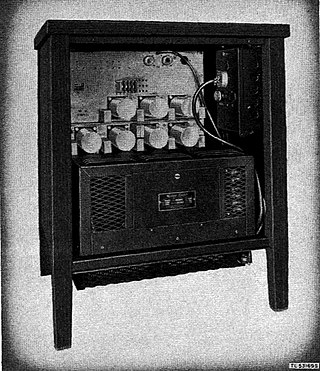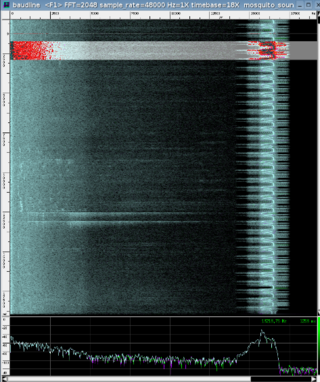Related Research Articles

The Advanced Encryption Standard (AES), also known by its original name Rijndael, is a specification for the encryption of electronic data established by the U.S. National Institute of Standards and Technology (NIST) in 2001.

Adi Shamir is an Israeli cryptographer and inventor. He is a co-inventor of the Rivest–Shamir–Adleman (RSA) algorithm, a co-inventor of the Feige–Fiat–Shamir identification scheme, one of the inventors of differential cryptanalysis and has made numerous contributions to the fields of cryptography and computer science.

Keystroke logging, often referred to as keylogging or keyboard capturing, is the action of recording (logging) the keys struck on a keyboard, typically covertly, so that a person using the keyboard is unaware that their actions are being monitored. Data can then be retrieved by the person operating the logging program. A keystroke recorder or keylogger can be either software or hardware.

A microphone, colloquially called a mic, is a transducer that converts sound into an electrical signal. Microphones are used in many applications such as telephones, hearing aids, public address systems for concert halls and public events, motion picture production, live and recorded audio engineering, sound recording, two-way radios, megaphones, and radio and television broadcasting. They are also used in computers for recording voice, speech recognition, VoIP, and for other purposes such as ultrasonic sensors or knock sensors.
Computer and network surveillance is the monitoring of computer activity and data stored locally on a computer or data being transferred over computer networks such as the Internet. This monitoring is often carried out covertly and may be completed by governments, corporations, criminal organizations, or individuals. It may or may not be legal and may or may not require authorization from a court or other independent government agencies. Computer and network surveillance programs are widespread today and almost all Internet traffic can be monitored.

TEMPEST is a U.S. National Security Agency specification and a NATO certification referring to spying on information systems through leaking emanations, including unintentional radio or electrical signals, sounds, and vibrations. TEMPEST covers both methods to spy upon others and how to shield equipment against such spying. The protection efforts are also known as emission security (EMSEC), which is a subset of communications security (COMSEC).

Daniel Julius Bernstein is an American German mathematician, cryptologist, and computer scientist. He is a visiting professor at CASA at Ruhr University Bochum, as well as a research professor of Computer Science at the University of Illinois at Chicago. Before this, he was a professor in the department of mathematics and computer science at the Eindhoven University of Technology.

David A. Wagner is a professor of computer science at the University of California, Berkeley and a well-known researcher in cryptography and computer security. He is a member of the Election Assistance Commission's Technical Guidelines Development Committee, tasked with assisting the EAC in drafting the Voluntary Voting System Guidelines. He is also a member of the ACCURATE project.
In cryptography, Skipjack is a block cipher—an algorithm for encryption—developed by the U.S. National Security Agency (NSA). Initially classified, it was originally intended for use in the controversial Clipper chip. Subsequently, the algorithm was declassified.
Van Eck phreaking, also known as Van Eck radiation, is a form of eavesdropping in which special equipment is used to pick up side-band electromagnetic emissions from electronic devices that correlate to hidden signals or data to recreate these signals or data to spy on the electronic device. Side-band electromagnetic radiation emissions are present in keyboards, computer displays, printers, and other electronic devices.
In cryptography, the eXtended Sparse Linearization (XSL) attack is a method of cryptanalysis for block ciphers. The attack was first published in 2002 by researchers Nicolas Courtois and Josef Pieprzyk. It has caused some controversy as it was claimed to have the potential to break the Advanced Encryption Standard (AES) cipher, also known as Rijndael, faster than an exhaustive search. Since AES is already widely used in commerce and government for the transmission of secret information, finding a technique that can shorten the amount of time it takes to retrieve the secret message without having the key could have wide implications.
In computer security, a side-channel attack is any attack based on extra information that can be gathered because of the fundamental way a computer protocol or algorithm is implemented, rather than flaws in the design of the protocol or algorithm itself or minor, but potentially devastating, mistakes or oversights in the implementation. Timing information, power consumption, electromagnetic leaks, and sound are examples of extra information which could be exploited to facilitate side-channel attacks.

Microphonics, microphony, or microphonism describes the phenomenon wherein certain components in electronic devices transform mechanical vibrations into an undesired electrical signal (noise). The term comes from analogy with a microphone, which is intentionally designed to convert vibrations to electrical signals.
In cryptography and number theory, TWIRL is a hypothetical hardware device designed to speed up the sieving step of the general number field sieve integer factorization algorithm. During the sieving step, the algorithm searches for numbers with a certain mathematical relationship. In distributed factoring projects, this is the step that is parallelized to a large number of processors.

The baudline time-frequency browser is a signal analysis tool designed for scientific visualization. It runs on several Unix-like operating systems under the X Window System. Baudline is useful for real-time spectral monitoring, collected signals analysis, generating test signals, making distortion measurements, and playing back audio files.

Ultrasonic transducers and ultrasonic sensors are devices that generate or sense ultrasound energy. They can be divided into three broad categories: transmitters, receivers and transceivers. Transmitters convert electrical signals into ultrasound, receivers convert ultrasound into electrical signals, and transceivers can both transmit and receive ultrasound.
Non-interactive zero-knowledge proofs are cryptographic primitives, where information between a prover and a verifier can be authenticated by the prover, without revealing any of the specific information beyond the validity of the statement itself. This function of encryption makes direct communication between the prover and verifier unnecessary, effectively removing any intermediaries. The core trustless cryptography "proofing" involves a hash function generation of a random number, constrained within mathematical parameters determined by the prover and verifier.

In computing, an input device is a piece of equipment used to provide data and control signals to an information processing system, such as a computer or information appliance. Examples of input devices include keyboards, mouse, scanners, cameras, joysticks, and microphones.
Computer security compromised by hardware failure is a branch of computer security applied to hardware. The objective of computer security includes protection of information and property from theft, corruption, or natural disaster, while allowing the information and property to remain accessible and productive to its intended users. Such secret information could be retrieved by different ways. This article focus on the retrieval of data thanks to misused hardware or hardware failure. Hardware could be misused or exploited to get secret data. This article collects main types of attack that can lead to data theft.
In cryptography, electromagnetic attacks are side-channel attacks performed by measuring the electromagnetic radiation emitted from a device and performing signal analysis on it. These attacks are a more specific type of what is sometimes referred to as Van Eck phreaking, with the intention to capture encryption keys. Electromagnetic attacks are typically non-invasive and passive, meaning that these attacks are able to be performed by observing the normal functioning of the target device without causing physical damage. However, an attacker may get a better signal with less noise by depackaging the chip and collecting the signal closer to the source. These attacks are successful against cryptographic implementations that perform different operations based on the data currently being processed, such as the square-and-multiply implementation of RSA. Different operations emit different amounts of radiation and an electromagnetic trace of encryption may show the exact operations being performed, allowing an attacker to retrieve full or partial private keys.
References
- ↑ Marchetti, Victor; Marks, John (1974). The CIA and the Cult of Intelligence . Knopf. ISBN 0394482395.
- ↑ Wright, Peter (1987), Spycatcher: The candid autobiography of a senior intelligence officer, Viking
- ↑ Yang, Sarah (14 September 2005). "Researchers recover typed text using audio recording of keystrokes". UC Berkeley News.
- ↑ Shamir, Adi; Tromer, Eran. "Acoustic cryptanalysis: On nosy people and noisy machines". tau.ac.il.
- ↑ Genkin, Daniel; Shamir, Adi; Tromer, Eran. "RSA Key Extraction via Low-Bandwidth Acoustic Cryptanalysis". tau.ac.il.
- ↑ "Capacitors for Reduced Micro phonics and Sound Emission" (PDF). CARTS 2007 Symposium Proceedings, Albuquerque. Electronic Components, Assemblies & Materials Association (ECA). March 2007. Archived from the original (PDF) on 2019-11-16. Retrieved 2014-01-24.
- ↑ "FoilQ, .50mH 16ga". Meniscusaudio.com. Archived from the original on 2014-02-20. Retrieved 2014-01-24.
- ↑ "50uF 250volt Metallized Polyester Mylar Film Capacitor-ERSE". Erseaudio.com. Retrieved 2014-01-24.
- ↑ Michael Backes; Markus Dürmuth; Sebastian Gerling; Manfred Pinkal; Caroline Sporleder (January 9, 2011). "Acoustic Side-Channel Attacks on Printers" (PDF). eecs.umich.edu. Retrieved March 10, 2015.
- ↑ Mathews, Lee (2018-08-31). "Now Hackers Can Spy On You By Listening To Your Screen". Forbes. Retrieved 2019-03-13.
- ↑ Genkin, Daniel; Shamir, Adi; Tromer, Eran (2016-02-08). "Acoustic Cryptanalysis". Journal of Cryptology. 30 (2): 392–443. doi:10.1007/s00145-015-9224-2. ISSN 0933-2790. S2CID 31377774.
- ↑ Asonov, Dmitri; Agrawal, Rakesh (2004), "Keyboard Acoustic Emanations" (PDF), IBM Almaden Research Center, archived from the original (PDF) on 2012-02-27, retrieved 2007-05-08